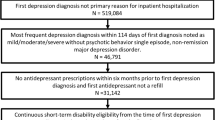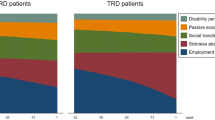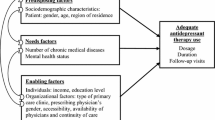Abstract
This study examined antidepressant adherence and persistence among uninsured working adults diagnosed with major depression enrolled in the Texas Demonstration to Maintain Independence and Employment (DMIE) program. Antidepressant adherence was measured between intervention and control cohorts using proportion of days covered (PDC) during a 365-day observation period. Persistence examined duration of time from drug initiation to discontinuation based on a ≥35-day refill supply gap. Older, non-minority patients with higher education were more adherent or persistent to antidepressant therapy. Adjusting for covariates, results showed no significant difference in PDC at the end of 12-months between intervention and control participants (b = .07, P = .054, semi-partial η 2 = .02). Exploratory analysis found subgroup differences in PDC among the study recruitment cohorts. No significant difference between intervention and control groups was found in persistence between the groups. Follow-up investigation is planned to assess the longer term impact of the DMIE program on antidepressant adherence and persistence.


Similar content being viewed by others
References
Akincigil, A., Bowblis, J., Levin, C., Walkup, J., Jan, S., & Crystal, S. (2007). Adherence to antidepressant treatment among privately insured patients diagnosed with depression. Medical Care, 45(4), 363–369.
Belle, D. (1990). Poverty and women’s mental health. American Psychologist, 45, 385–389.
Benner, J. S., Glynn, R. J., Mogun, H., Neumann, P. J., Weinstein, M. C., & Avorn, J. (2002). Long-term persistence in use of statin therapy in elderly patients. JAMA, 288, 455–461.
Brown, C., Schulberg, H. C., Sacco, D., Perel, J. M., & Houck, P. R. (1999). Effectiveness of treatments for major depression in primary medical care practice: A post hoc analysis of outcomes for African American and white patients. Journal of Affective Disorders, 53(2), 185–192.
Centers for Disease Control and Prevention (CDC). (2010). Current depression among adults: United States, 2006 and 2008. Morbidity and Mortality Weekly Report (MMWR), 59(38), 1229–1235.
Chen, R. S., & Rosenheck, R. (2001). Using a computerized patient database to evaluate guideline adherence and measure patterns of care for major depression. Journal of Behavioral Health Services and Research, 28, 466–474.
Cohen, J., Cohen, P., West, S. G., & Aiken, L. S. (2003). Applied multiple regression/correlation analysis for the behavioral sciences (3rd ed.). Mahwah, NJ: Lawrence Erlbaum Associates, Inc.
Cramer, J., Roy, A., & Burrell, A. (2008). Medication compliance and persistence: Terminology and definitions. Value in Health, 11(1), 44–47.
Demyttenaere, K., & Haddad, P. (2008). Compliance with antidepressant therapy and antidepressant discontinuation symptoms. Acta Psychiatrica Scandinavica, 403, 50–56.
Dopp, J. M., & Phillips, B. G. (2008). Chapter 75: Sleep disorders. In J. T. DiPiro et al. (Eds.), Pharmacotherapy: A pathophysiologic approach (7th ed., pp 1191–1201). New York, NY: McGraw-Hill Companies, Inc.
Gill, D., & Hatcher, S. (1999). A systematic review of the treatment of depression with antidepressant drugs in patients who also have a physical illness. Journal of Psychosomatic Research, 47(2), 131–143.
Gimm, G., Denny-Brown, N., Gilman, B., Ireys, H., Anderson, T. (2009). Interim report on the demonstration to maintain independence and employment. Mathematica Policy Research, Inc. Retrieved from http://www.mathematica-mpr.com/publications/pdfs/disability/dmie-interimrpt.pdf.
Kessler, R., Akiskal, H., & Ames, M. (2006). Prevalence and effects of mood disorders on work performance in a nationally representative sample of US workers. American Journal of Psychiatry, 163, 1561–1568.
Kessler, R., Berglund, P., Demler, O., Jin, R., Koretz, D., Merikangas, K., et al. (2003). The epidemiology of major depressive disorder: Results from the National Comorbidity Survey Replication (NCS-R). JAMA, 289(23), 3095–3105.
Kessler, R., Chiu, W., Demler, O., Merikangas, K., & Walters, E. (2005). Prevalence, severity, and comorbidity of 12-month DSM-IV disorders in the National Comorbidity Survey Replication. Archives of General Psychiatry, 62(6), 617–627.
Kirkwood, C. K. (1999). Management of insomnia. Journal of the American Pharmacists Association, 39(5), 688–696.
Leslie, S., Gwadry-Sridhar, F., Thiebaud, P., & Patel, B. (2008). Pharmaceutical Programming, 1(1), 13–19.
Mann, J. (2005). The medical management of depression. New England Journal of Medicine, 353(17), 1819–1834.
Murray, C. J., & Lopez, A. D. (1996). The global burden of disease: A comprehensive assessment of mortality and disability from diseases, injuries and risk factors in 1990 and projected to 2020, Global Burden of Disease and Injury Series (Vol. 1). Cambridge, MA: Harvard School of Public Health.
National Committee for Quality Assurance (NCQA). (2009). Healthcare Effectiveness Data and Information Set (HEDIS) (Vol. 2). Washington, DC: NCQA.
National Institute of Mental Health. (2009, July 20). The numbers count: Mental disorders in America. Retrieved from http://www.nimh.nih.gov/health/publications/the-numbers-count-mental-disorders-in-america/index.shtml#Intro.
Osterberg, L., & Blaschke, T. (2005). Adherence to medication. New England Journal of Medicine, 353(5), 487–497.
Peterson, A. M., Nau, D. P., Cramer, J. A., Benner, J., Gwadry-Sridhar, F., & Nichol, M. (2007). A Checklist for medication compliance and persistence studies using retrospective databases. Value in Health, 10(1), 3–12.
Reid, R. J., MacWilliam, L., Verhulst, L., Roos, N., & Atkinson, M. (2001). Performance of the ACG case-mix system in two Canadian provinces. Medical Care, 39(1), 86–99.
Smith, J. L., Rost, K. M., Nutting, P. A., & Elliot, C. E. (2001). Resolving disparities in antidepressant treatment and quality-of-life outcomes between uninsured and insured primary care patients with depression. Medical Care, 39(9), 910–922.
Smith, J., Rost, K., Nutting, P., Elliott, C., & Dickinson, L. (2002). Impact of ongoing primary care intervention on long term outcomes in uninsured and insured patients with depression. Medical Care, 40, 1210–1222.
Stack, J. A., Paradis, C. F., Reynolds, C. F., Houck, P. R., Frank, E., Anderson, B., et al. (1995). Does recruitment method make a difference? Effects on protocol retention and treatment outcome in elderly depressed patients. Journal of Psychiatric Research, 56(1), 17–24.
Stagnitti, M. (2005). Antidepressant use in the US Civilian Non-Institutionalised Population, 2002. Statistical Brief #77. Medical Expenditure Panel. Rockville, MD: Agency for Healthcare Research and Quality.
U.S. Department of Health and Human Services. (1999). Chapter 2: Mental health: A report of the surgeon general. Rockville, MD: U.S. Department of Health and Human Services, Substance Abuse and Mental Health Services Administration, Center for Mental Health Services, National Institutes of Health, National Institute of Mental Health.
Vanelli, M., & Coca-Perraillon, M. (2008). Role of patient experience in antidepressant adherence: A retrospective data analysis. Clinical Therapeutics, 30(9), 1737–1745.
Wang, P. S., Lane, M., Olfson, M., Pincus, H. A., Wells, K. B., & Kessler, R. C. (2005). Twelve-month use of mental health services in the U.S.: Results from the National Comorbidity Survey Replication (NCS-R). Archives of General Psychiatry, 62, 629–640.
World Health Organization (WHO). (2009). Non-communicable diseases. SEAR. Retrieved from http://www.searo.who.int/en.
Acknowledgments
This research was funded a grant from the Centers for Medicare and Medicaid Services (CMS). The study was administered by Texas Department of State Health Services (TDSHS). Interventions were provided by or contracted through HCHD. This article does not represent the views and opinions of CMS and DSHS. We would like to thank Lu Gan, MS and Patricia Bennett, MS, of the Addiction Research Institute at the University of Texas at Austin for their support in the data management and statistical analysis for this study. We would also like to thank Allen Pittman, MSSW and Tim Weatherby, MBA at the Texas Department of State Health Services, and Doris Chimera, RN, MS of the HCHD, for their input in the design and review of the study.
Author information
Authors and Affiliations
Corresponding author
Rights and permissions
About this article
Cite this article
Nwokeji, E.D., Bohman, T.M., Wallisch, L. et al. Evaluating Patient Adherence to Antidepressant Therapy Among Uninsured Working Adults Diagnosed with Major Depression: Results of the Texas Demonstration to Maintain Independence and Employment Study. Adm Policy Ment Health 39, 374–382 (2012). https://doi.org/10.1007/s10488-011-0354-z
Published:
Issue Date:
DOI: https://doi.org/10.1007/s10488-011-0354-z




